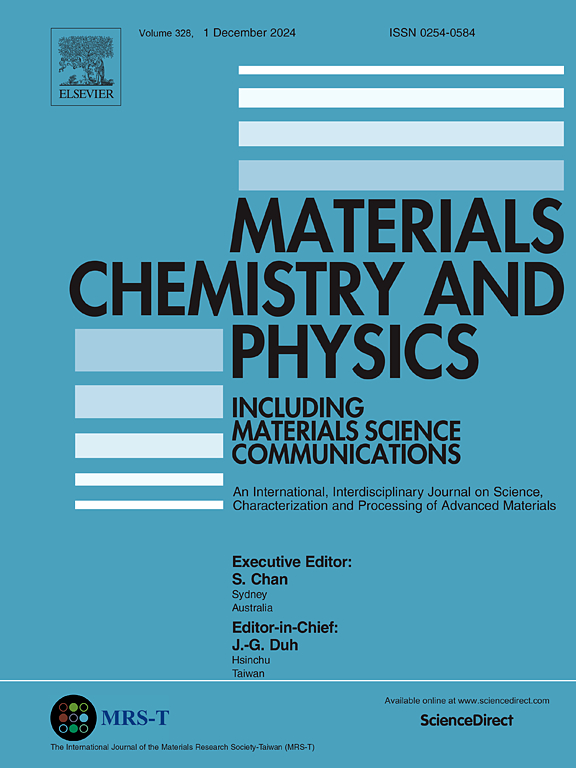高性能锂离子电池用二维金属三硒化磷的高熵启发构造
IF 4.3
3区 材料科学
Q2 MATERIALS SCIENCE, MULTIDISCIPLINARY
引用次数: 0
摘要
二维(2D)金属三硒化磷通过范德华相互作用堆叠,具有巨大的锂存储潜力,但作为电池器件中的电极材料,其性能仍未达到预期的水平。在此,我们提出了一种简单的固相烧结结合超声辅助剥离的方法来合成具有高熵的大尺度2D (FeMnCoNiCu)PSe3 (HEPSe3)。多阳离子的掺入有效地缓解了过渡金属三硒化磷材料中观察到的导电性差和结构崩溃易感性等问题。经过精心设计的HEPSe3在锂离子电池中,在100 mA g−1的电流密度下,经过250次循环,其放电容量达到728 mAh g−1,在高电流密度(10 a g−1)下,其放电容量达到488 mAh g−1,使用寿命长达4000次。它还具有出色的速率性能。密度泛函理论计算表明,高熵结构中多个阳离子之间的协同相互作用大大降低了HEPSe3的离子迁移能垒。此外,当涉及到袋式全电池时,HEPSe3的重量能量密度为382.1 Wh kg−1。该研究为支持HEPSe3在碱离子电池中的预期适用性提供了强有力的证据,同时代表了在储能装置中利用二维金属三硒化磷层状材料的重大进展。本文章由计算机程序翻译,如有差异,请以英文原文为准。
High-entropy-Inspired construction of two-dimensional metal phosphorus tri-selenides for superior-performance lithium-ion batteries
Two-dimensional (2D) metal phosphorus tri-selenide is stacked by van der Waals interaction with huge potential for lithium storage, but still not performed as well as anticipated as an electrode material in battery devices. Here, we present a facile solid-phase sintering approach combined with ultrasonically-assisted stripping to synthesize large-scale 2D (FeMnCoNiCu)PSe3 (HEPSe3) with high entropy. The incorporation of multi-cations effectively mitigates the issues associated with poor electrical conductivity and susceptibility to structural collapse observed in transition metal phosphorus tri-selenide materials. The well-designed HEPSe3 exhibits a high discharge capacity reaching 728 mAh g−1 after 250 cycles at a current density of 100 mA g−1 in lithium-ion batteries, and a long-life time of 4000 cycles with a high capacity of 488 mAh g−1 under high current density (10 A g−1). It also performs an outstanding rate performance. Density functional theory computations demonstrate that the cooperative interactions among multiple cations within high entropy architectures substantially lower the ion migration energy barriers of HEPSe3. Additionally, when comes to pouch-type full cell, the HEPSe3 performs a gravimetric energy density of 382.1 Wh kg−1. This study provides strong evidence to support the prospective applicability of HEPSe3 in alkali-ion batteries, while representing significant advancements towards leveraging 2D metal phosphorus tri-selenide layered materials in energy storage devices.
求助全文
通过发布文献求助,成功后即可免费获取论文全文。
去求助
来源期刊

Materials Chemistry and Physics
工程技术-材料科学:综合
CiteScore
8.70
自引率
4.30%
发文量
1515
审稿时长
69 days
期刊介绍:
Materials Chemistry and Physics is devoted to short communications, full-length research papers and feature articles on interrelationships among structure, properties, processing and performance of materials. The Editors welcome manuscripts on thin films, surface and interface science, materials degradation and reliability, metallurgy, semiconductors and optoelectronic materials, fine ceramics, magnetics, superconductors, specialty polymers, nano-materials and composite materials.
 求助内容:
求助内容: 应助结果提醒方式:
应助结果提醒方式:


